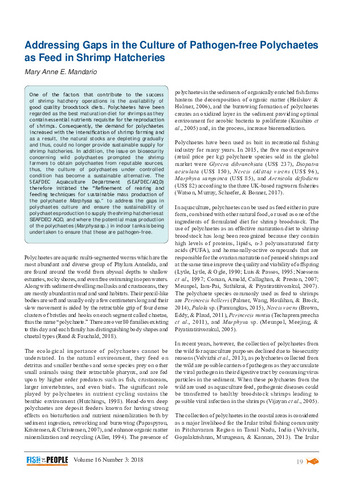Addressing gaps in the culture of pathogen-free polychaetes as feed in shrimp hatcheries
Share
Abstract
One of the factors that contribute to the success of shrimp hatchery operations is the availability of good quality broodstock diets. Polychaetes have been regarded as the best maturation diet for shrimps as they contain essential nutrients requisite for the reproduction of shrimps. Consequently, the demand for polychaetes increased with the intensification of shrimp farming and as a result, the natural stocks are depleting gradually and thus, could no longer provide sustainable supply for shrimp hatcheries. In addition, the issue on biosecurity concerning wild polychaetes prompted the shrimp farmers to obtain polychaetes from reputable sources, thus, the culture of polychaetes under controlled condition has become a sustainable alternative. The SEAFDEC Aquaculture Department (SEAFDEC/AQD) therefore initiated the “Refinement of rearing and feeding techniques for sustainable mass production of the polychaete Marphysa sp.” to address the gaps in polychaetes culture and ensure the sustainability of polychaetes production to supply the shrimp hatcheries at SEAFDEC/AQD, and where the potential mass production of the polychaetes (Marphysa sp.) in indoor tanks is being undertaken to ensure that these are pathogen-free.
Suggested Citation
Mandario, M. A. E. (2018). Addressing gaps in the culture of pathogen-free polychaetes as feed in shrimp hatcheries. Fish for the People , 16(3), 19-23. http://hdl.handle.net/20.500.12066/4332


